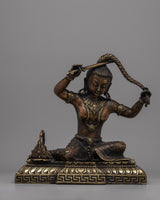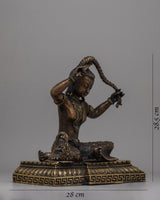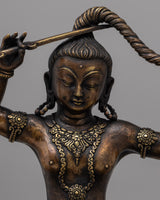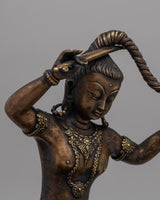









Siddhartha Renunciation Statue | Capturing the Moment of Spiritual Awakening and Asceticism

100% AUTHENTIC

HANDMADE

FREE SHIPPING
Siddhartha Renunciation Statue
About Our Statue
Carefully carved from brass, the Siddhartha Renunciation Statue depicts a crucial period in the life of the future Buddha, Siddhartha Gautama. This handcrafted statue depicts Siddhartha's wise choice to give up material pleasures and set out on a spiritual journey to achieve enlightenment. This 4.15 kg statue, with fine workmanship, perfectly depicts the solemnity and resolve shown in Siddhartha's posture and demeanor as he sets off on his quest for awakening.
The Siddhartha Renunciation Statue is a potent reminder of the transience of earthly pursuits and the search of inner calm and liberation. It symbolizes the giving up of material attachments and the pursuit of spiritual truth. This statue encourages contemplation on the road to enlightenment and the transformational potential of renunciation, whether it is exhibited in residences, meditation areas, or temples. Instigating contemplation on the ultimate truth and the deeper meaning of life, this statue serves as a concrete depiction of Siddhartha Gautama's profound spiritual journey.
Siddhartha Gautama Denouncing His Religion
The statue portrays an event in Buddha's Life where he denounced his religion. Renunciation, commonly known as Siddhartha Gautam Buddha's abandonment of religion, is a crucial turning point in his life. It alludes to when he gave up his lavish lifestyle and regal title to become an ascetic in pursuit of the truth and a means to end the misery.
This incident served as the catalyst for his enlightenment and the foundation of Buddhism, marking the start of his spiritual path. According to legend, Siddhartha Gautam was deeply troubled by the suffering he observed around him at the age of 29, which led him to renounce his life of luxury and seek a deeper comprehension of the nature of existence.
His renunciation represents the significance of Buddhism's quest for spiritual truth and separation from sensual pleasures. It teaches us the importance of letting go of attachments and desires that bring us to pain instead of engaging in spiritual practice to achieve inner tranquility and contentment.
Buddha's renunciation of religion serves as a reminder of the value of letting go of suffering-causing materialistic wants and attachments. Realizing that contentment and inner serenity could only be obtained by spiritual practice and enlightenment, he understood that life's pleasures and comforts were transient and illusory. This experience teaches us the value of self-control and renunciation, as well as the necessity of letting go of material belongings and wants in order to achieve higher spiritual aspirations.
-------------------------------------------------------
Size: 28.5cm (Height) x 28cm (Width)
Weight: 4.15 kg
Materials: Brass
-------------------------------------------------------
Introduction to Shakyamuni Buddha
Shakyamuni Buddha is also known as the enlightened one who is the founder of Buddhism and its teachings. The ancient Sanskrit word 'Buddha' means 'having become awoken ' in the sense of having attained 'supreme awareness.' It is closely related to the term 'Bodhi', which refers to awareness. His main goal was to free people from their suffering. Shakyamuni Buddha's teachings are based on his insight into suffering.




















